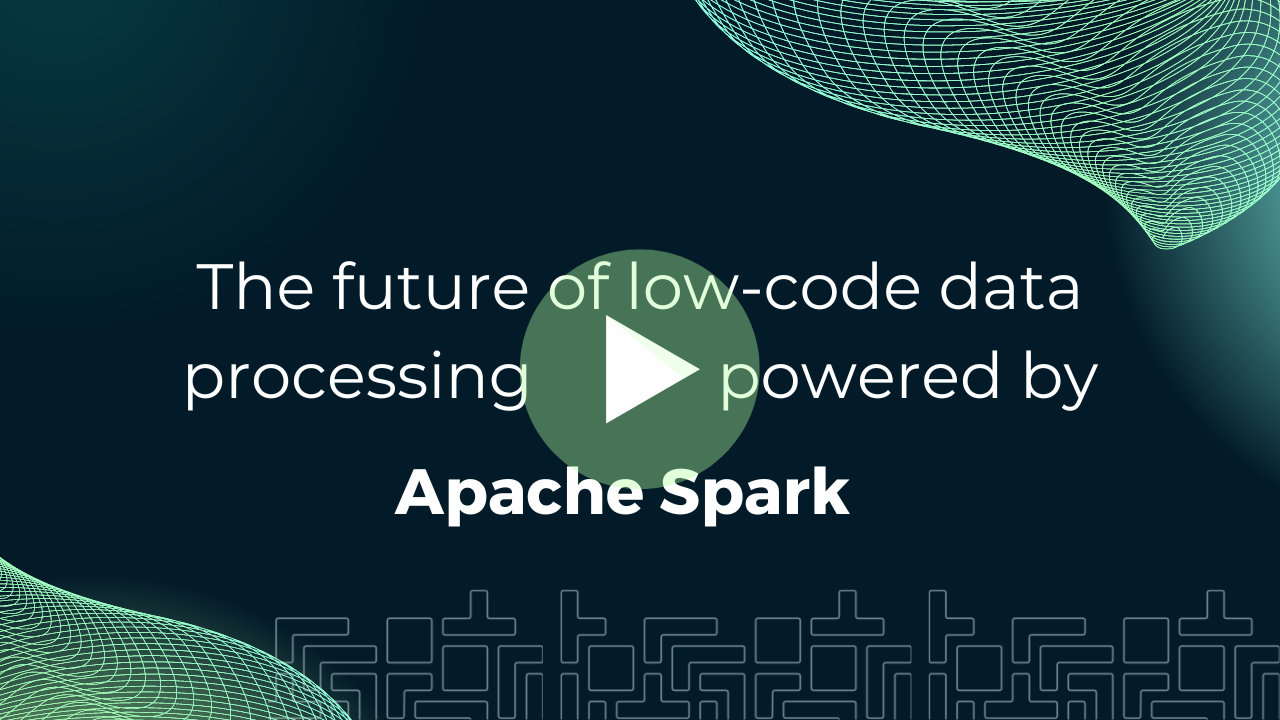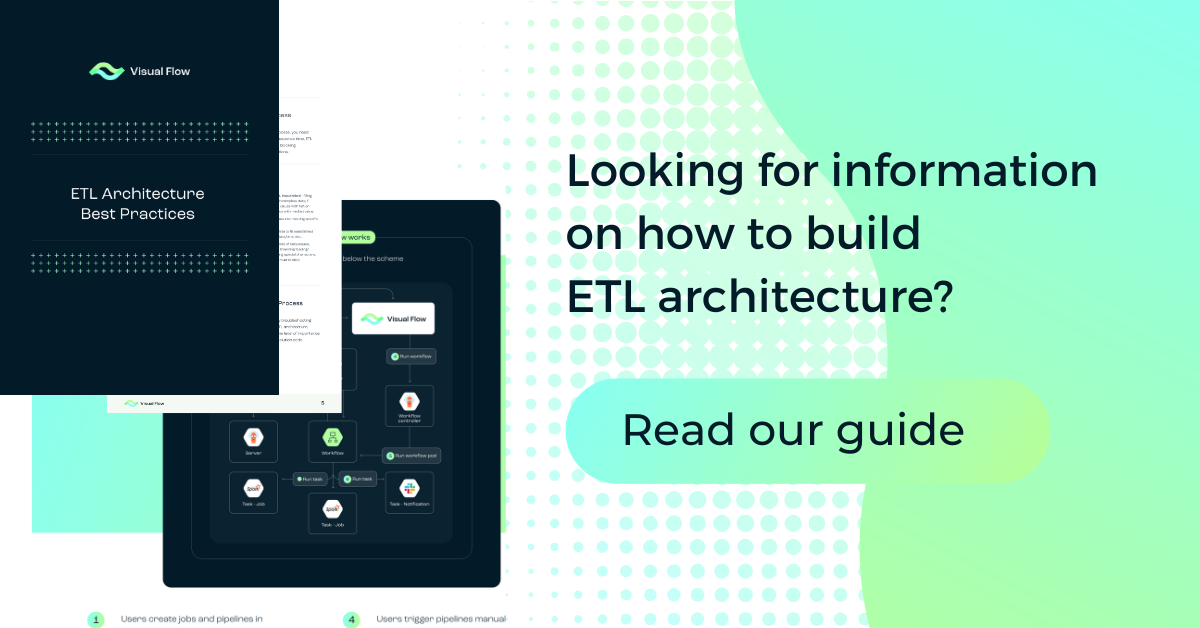
Table of Content:
Table of Content:


ETL vs ELT — this debate is alive because each method means a unique way of handling data and collecting business insights. This article will break down these concepts into bite-sized, understandable chunks, to help you understand the difference between ELT and ETL and figure out the best approach for managing your data.
What is ETL
ETL stands for Extract, Transform, Load. It’s a tried-and-tested method used in data integration that involves three distinct steps:
- Extract — pulling data from various sources ranging from databases and CRM systems to flat files and web services.
- Transform — cleaning, enriching, and reformatting the data after extracting it.
- Load — moving the transformed data into a target repository, such as a data warehouse, where it can be accessed and analyzed by business users.
ETL accumulates and transforms accurate, timely, and actionable data from disparate data sources into a unified asset. If you want to learn more about ETL processes and get a comprehensive ETL migration consultation, the Visual Flow experts are ready to share their wisdom with you.
How does ETL Work?
The ETL process operates through three stages of moving data from source systems to a destination like a data warehouse.
1. During the extraction stage, data is collected from multiple source systems, such as relational databases, CRM systems, marketing platforms, and more. The goal here is to accurately gather the raw data without altering its original state. This step means dealing with various data formats and structures, including CSV files, SQL databases, and even real-time data streams.
2. Then, the extracted data undergoes numerous modifications. The transformation step includes:
- Cleaning incorrect, incomplete, or duplicate data.
- Standardizing data formats, values, and units for consistency.
- Enriching data value by incorporating additional information from external sources.
- Aggregation, or summarizing detailed data for higher-level analysis.
- Filtering only the relevant pieces of data for loading.
- Ensuring data meets established quality and integrity criteria.
Each transformation rule applied makes the data ready for analytical querying.
3. In the final stage, the transformed data is loaded into the destination system — a data warehouse, data lake, or any other storage solution. The loading process is usually done in batches, where data is moved at scheduled intervals, or in real-time (it requires a continuous flow of data into the target system). Once the data is successfully loaded, it can be used by business analysts, data scientists, and decision-makers to extract insights, inform strategy, and drive business outcomes.
ETL is like organizing a big, messy collection of books into an orderly library. You gather all the books (data) you have, sort them out and clean them up (transform), and then put them neatly on the shelf (load) so everyone can find and use them easily. There is a wide range of AWS ETL managing tools available because sometimes it’s better to trust organizing such a large amount of data to professionals in this field.
Pros and Cons
Here are the primary pros and cons of ETL:
Pros
- Better data quality.
- Faster system performance.
- Keeping data safe.
- Growing with your business.
- Storing historical data.
Cons
- Complexity and overhead.
- Time-consuming.
- Rigidity.
- Batch processing limitations.
- Upfront costs.
Understanding these ups and downs will help determine if ETL is the right fit for your data handling needs.
Use Cases
ETL processes can be applied in numerous scenarios across different industries, such as:
Data Warehousing
- Scenario: a retail company needs to consolidate sales data from multiple stores into a single repository for analysis.
- Use case: ETL is used to extract sales data from each store’s system, transform it into a standard format, and load it into a central data warehouse. This enables the company to analyze trends, performance, and customer behavior across all stores.
Customer Relationship Management (CRM)
- Scenario: an e-commerce business wants to create a 360-degree view of customer interactions for better personalization.
- Use case: ETL is used to integrate data from various touchpoints — website visits, purchases, support tickets, and social media interactions. The unified data in the CRM system helps create personalized marketing campaigns and improve customer service.
What is ELT
ELT, in turn, stands for Extract, Load, Transform. It’s a modern approach to handling data that flips part of the traditional ETL (Extract, Transform, Load) process. In ELT, the data is first extracted from its source, then loaded directly into a target data storage system, and finally transformed within the storage system itself.
How does ETL Work?
ETL process includes the following steps:
- Extract. In the extraction phase, data is collected from multiple source systems. These sources are diverse, including databases, CRM systems, flat files, APIs, and more. The goal here is to accurately pull the data without changing its original format.
- Transform. Then, the extracted data undergoes various modifications to tailor it for the target system and intended analysis tasks. Transformations include cleaning (removing inaccuracies or duplicates), normalization (adjusting data to a standard format), enrichment (adding additional relevant information), and aggregation (summarizing detailed data for higher-level analysis).
- Load. The final stage involves loading the transformed data into a destination system, such as a data warehouse, database, or data lake, depending on where the data will be accessed and analyzed. Loading can be done in batches (at scheduled times) or in real time. Batch loading is common when immediate access to the data isn’t necessary, whereas real-time loading supports scenarios requiring up-to-the-minute data for decision-making.
So, ETL moves and refines raw data from various sources into a structured and unified format in a target repository.

Pros and Cons
Here are the key pros and cons of ETL:
Pros
- Makes data trustworthy.
- Brings data together.
- Keeps systems running fast.
- Saves time with automation.
- Helps to make better decisions.
Cons
- Can get complicated.
- May consume time.
- Hard to modify.
- Not always up-to-the-minute.
- Initial costs.
While ETL has challenges, its benefits make it a valuable asset for your data strategy.
Use Cases
Here is how ETL processes can be used in real scenarios:
Consolidating Business Data into a Data Warehouse
- Scenario: a retail company operates both online and offline stores and wants to analyze overall sales performance.
- Use case: ETL processes extract sales data from various sources — like in-store point-of-sale systems, online sales platforms, and inventory management systems — transform this data into a consistent format, and load it into a central data warehouse to allow for comprehensive analysis of sales trends, inventory levels, and customer behavior across all channels.
Customer Data Integration for a Unified View
- Scenario: a telecommunications company wants to enhance its customer service by having a 360-degree view of customer interactions.
- Use case: ETL is used to pull data from different customer interaction points — such as call logs, service usage records, billing systems, and customer feedback platforms to better understand customer needs, preferences, and issues.
Key Differences Between ETL and ELT
The difference between ETL and ELT is typically in the following aspects:
When They Tidy up the Data
- ETL. Cleans up and organizes the data before moving it to its new destination.
- ELT. Moves the data first and then tidies it up in its new location.
Where They Work Best
- ETL. Works well with traditional systems where everything needs to be neat and organized before it can be used.
- ELT. Fits better with modern, flexible systems that don’t mind if things are a bit messy at first, as long as they get organized eventually.
Speed and Muscle
- ETL. Can get slowed down if there’s a lot of data to clean up before moving.
- ELT. Uses the power of modern systems to quickly move and manage even huge amounts of data without much wait.
Changing Things up
- ETL. Making changes or adding something new can be a bit of a project because you have to adjust the cleaning process.
- ELT. More laid-back when it comes to changes since the data is already available in its raw form.
Ready for Action
- ETL. Takes a while to get the data ready for use, especially if there’s a lot of it.
- ELT. Gets the data ready for action quicker, especially helpful if you need fresh, up-to-the-minute insights.
Complexity and Cost
- ETL. Requires more planning and effort upfront, which can mean more time and money spent.
- ELT. Potentially lower complexity and cost by shifting the transformation responsibilities to the target system, simplifying the overall architecture.
The choice between ETL and ELT first depends on the nature of the data, the intended use cases, scalability needs, existing infrastructure, and budget constraints.
Which is Better for Your Business: ETL or ELT?
ELT vs ETL — what is better for your business and what are the ETL vs ELT pros and cons? Let’s find out.
It’s advisable to choose ETL versus ELT when:
- You rely on traditional data warehouses.
- Data quality is important.
- Complex data transformations are required.
- Limited storage and computing resources.
ETL is better for your business needs when:
- You’re using cloud-based data warehouses.
- Real-time data access is essential.
- Scalability is important.
- Flexibility is required for future changes.
This is what you should consider before choosing between ETL or ELT:
- Assess how each approach affects compliance with data privacy regulations relevant to your industry, especially if sensitive data is involved.
- Consider the initial setup and ongoing operational costs. ELT may have higher storage costs due to storing raw data, while ETL requires more investment in data processing infrastructure.
- Think about the skills available within your team and the complexity of maintaining the chosen system over time.
The ETL vs ELT choice depends on what your business aims to achieve, the tech skills you have in-house, how much you’re willing to spend, and how you want to use your data. Sometimes, mixing both ETL and ELT strategies works best.
Final Thoughts
So, if your priority is data precision and your systems are more traditional, choose ETL. On the other hand, if you want to scale quickly and you’re keen on using cloud technologies, then ELT may be more efficient. It’s also worth considering that sometimes a combination of both is the best solution.








Contact us






















































